Reflective Learning and Feedback in Higher Education Module
VerifiedAdded on 2023/06/07
|7
|2038
|415
Essay
AI Summary
This essay analyzes the importance of reflective learning in higher education, focusing on the role of feedback and feedforward in improving formative and summative assessments. It emphasizes the significance of self-reflection for learners to enhance critical thinking and apply concepts effectively. The essay discusses Gibbs Reflective Model, which includes description, feelings, evaluation, analysis, conclusion, and action plan, as a framework for analyzing learning experiences. It highlights how formative and summative feedback mechanisms contribute to student growth and academic success, enabling students to track their learning, understand their strengths and weaknesses, and make necessary improvements. The essay concludes that reflective learning, combined with effective feedback, is crucial for student development and achievement in higher education.
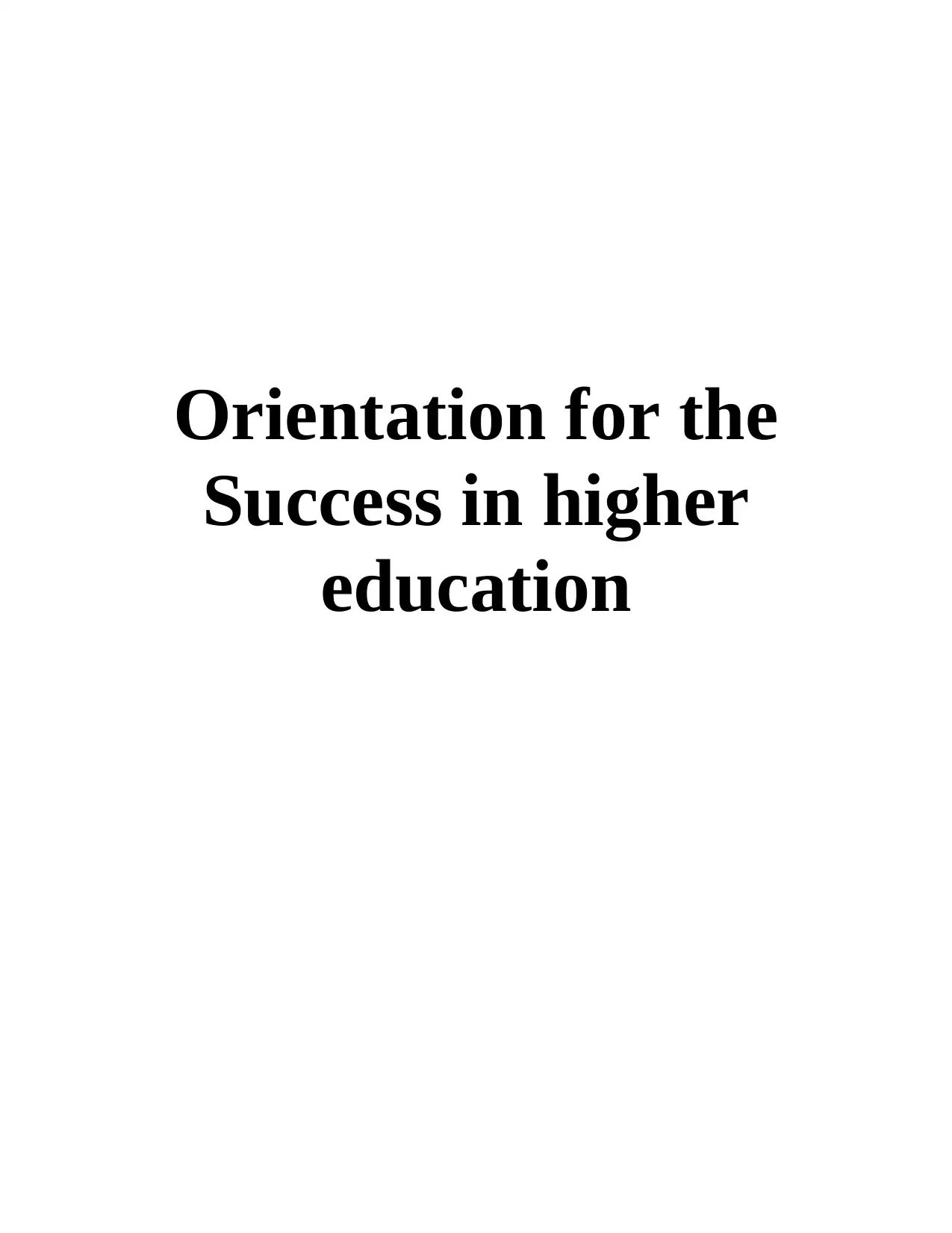
Orientation for the
Success in higher
education
Success in higher
education
Paraphrase This Document
Need a fresh take? Get an instant paraphrase of this document with our AI Paraphraser
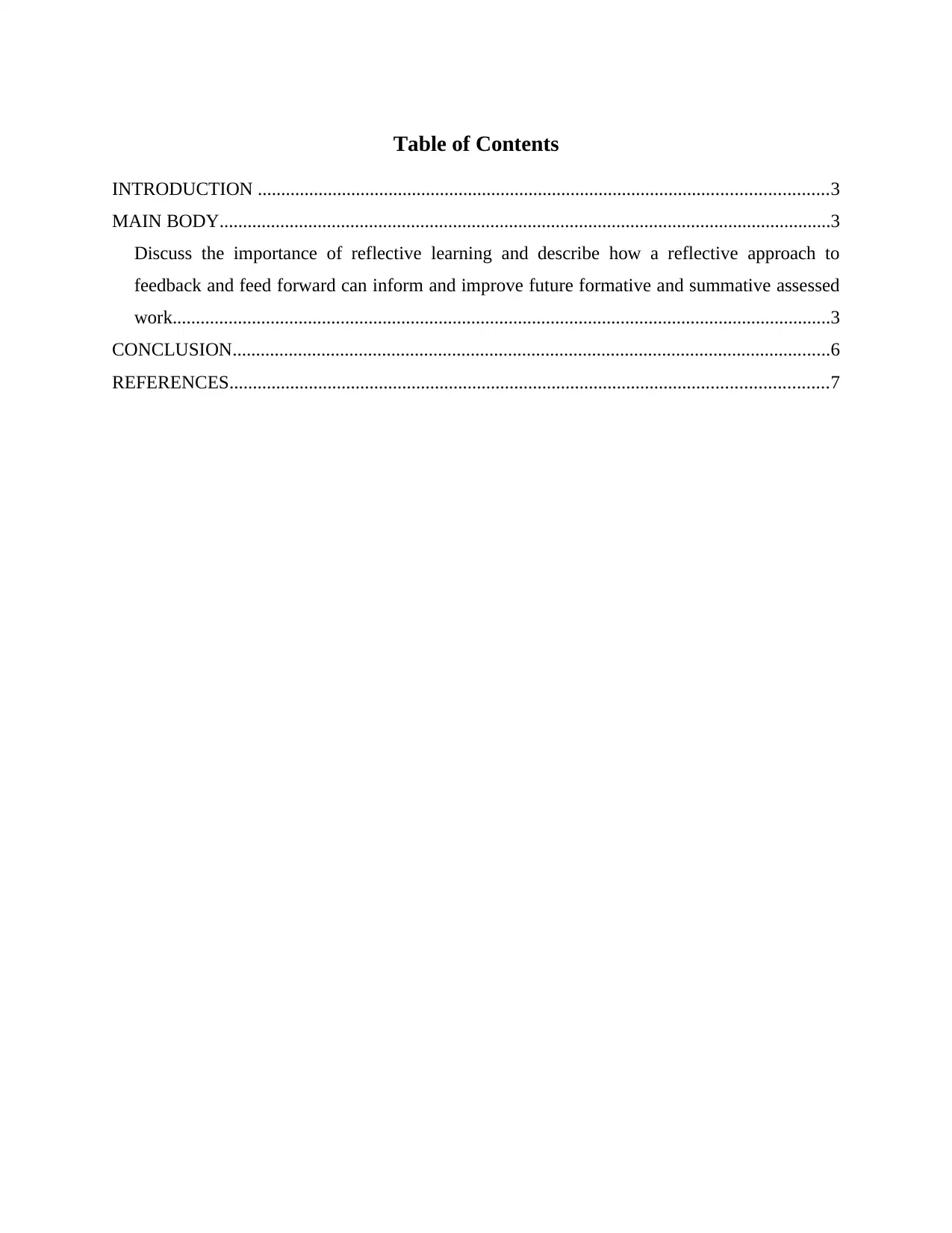
Table of Contents
INTRODUCTION ..........................................................................................................................3
MAIN BODY...................................................................................................................................3
Discuss the importance of reflective learning and describe how a reflective approach to
feedback and feed forward can inform and improve future formative and summative assessed
work.............................................................................................................................................3
CONCLUSION................................................................................................................................6
REFERENCES................................................................................................................................7
INTRODUCTION ..........................................................................................................................3
MAIN BODY...................................................................................................................................3
Discuss the importance of reflective learning and describe how a reflective approach to
feedback and feed forward can inform and improve future formative and summative assessed
work.............................................................................................................................................3
CONCLUSION................................................................................................................................6
REFERENCES................................................................................................................................7
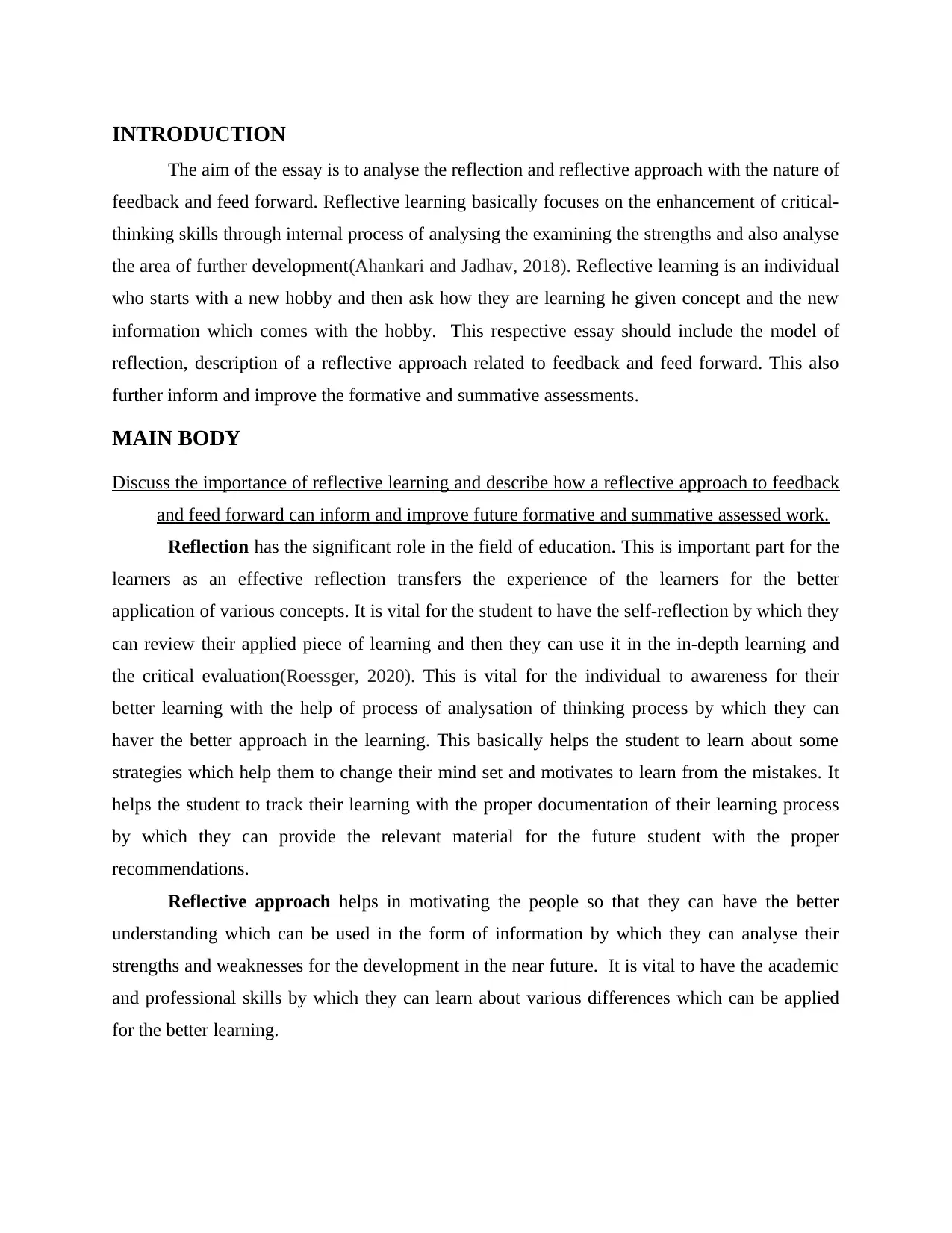
INTRODUCTION
The aim of the essay is to analyse the reflection and reflective approach with the nature of
feedback and feed forward. Reflective learning basically focuses on the enhancement of critical-
thinking skills through internal process of analysing the examining the strengths and also analyse
the area of further development(Ahankari and Jadhav, 2018). Reflective learning is an individual
who starts with a new hobby and then ask how they are learning he given concept and the new
information which comes with the hobby. This respective essay should include the model of
reflection, description of a reflective approach related to feedback and feed forward. This also
further inform and improve the formative and summative assessments.
MAIN BODY
Discuss the importance of reflective learning and describe how a reflective approach to feedback
and feed forward can inform and improve future formative and summative assessed work.
Reflection has the significant role in the field of education. This is important part for the
learners as an effective reflection transfers the experience of the learners for the better
application of various concepts. It is vital for the student to have the self-reflection by which they
can review their applied piece of learning and then they can use it in the in-depth learning and
the critical evaluation(Roessger, 2020). This is vital for the individual to awareness for their
better learning with the help of process of analysation of thinking process by which they can
haver the better approach in the learning. This basically helps the student to learn about some
strategies which help them to change their mind set and motivates to learn from the mistakes. It
helps the student to track their learning with the proper documentation of their learning process
by which they can provide the relevant material for the future student with the proper
recommendations.
Reflective approach helps in motivating the people so that they can have the better
understanding which can be used in the form of information by which they can analyse their
strengths and weaknesses for the development in the near future. It is vital to have the academic
and professional skills by which they can learn about various differences which can be applied
for the better learning.
The aim of the essay is to analyse the reflection and reflective approach with the nature of
feedback and feed forward. Reflective learning basically focuses on the enhancement of critical-
thinking skills through internal process of analysing the examining the strengths and also analyse
the area of further development(Ahankari and Jadhav, 2018). Reflective learning is an individual
who starts with a new hobby and then ask how they are learning he given concept and the new
information which comes with the hobby. This respective essay should include the model of
reflection, description of a reflective approach related to feedback and feed forward. This also
further inform and improve the formative and summative assessments.
MAIN BODY
Discuss the importance of reflective learning and describe how a reflective approach to feedback
and feed forward can inform and improve future formative and summative assessed work.
Reflection has the significant role in the field of education. This is important part for the
learners as an effective reflection transfers the experience of the learners for the better
application of various concepts. It is vital for the student to have the self-reflection by which they
can review their applied piece of learning and then they can use it in the in-depth learning and
the critical evaluation(Roessger, 2020). This is vital for the individual to awareness for their
better learning with the help of process of analysation of thinking process by which they can
haver the better approach in the learning. This basically helps the student to learn about some
strategies which help them to change their mind set and motivates to learn from the mistakes. It
helps the student to track their learning with the proper documentation of their learning process
by which they can provide the relevant material for the future student with the proper
recommendations.
Reflective approach helps in motivating the people so that they can have the better
understanding which can be used in the form of information by which they can analyse their
strengths and weaknesses for the development in the near future. It is vital to have the academic
and professional skills by which they can learn about various differences which can be applied
for the better learning.
⊘ This is a preview!⊘
Do you want full access?
Subscribe today to unlock all pages.

Trusted by 1+ million students worldwide
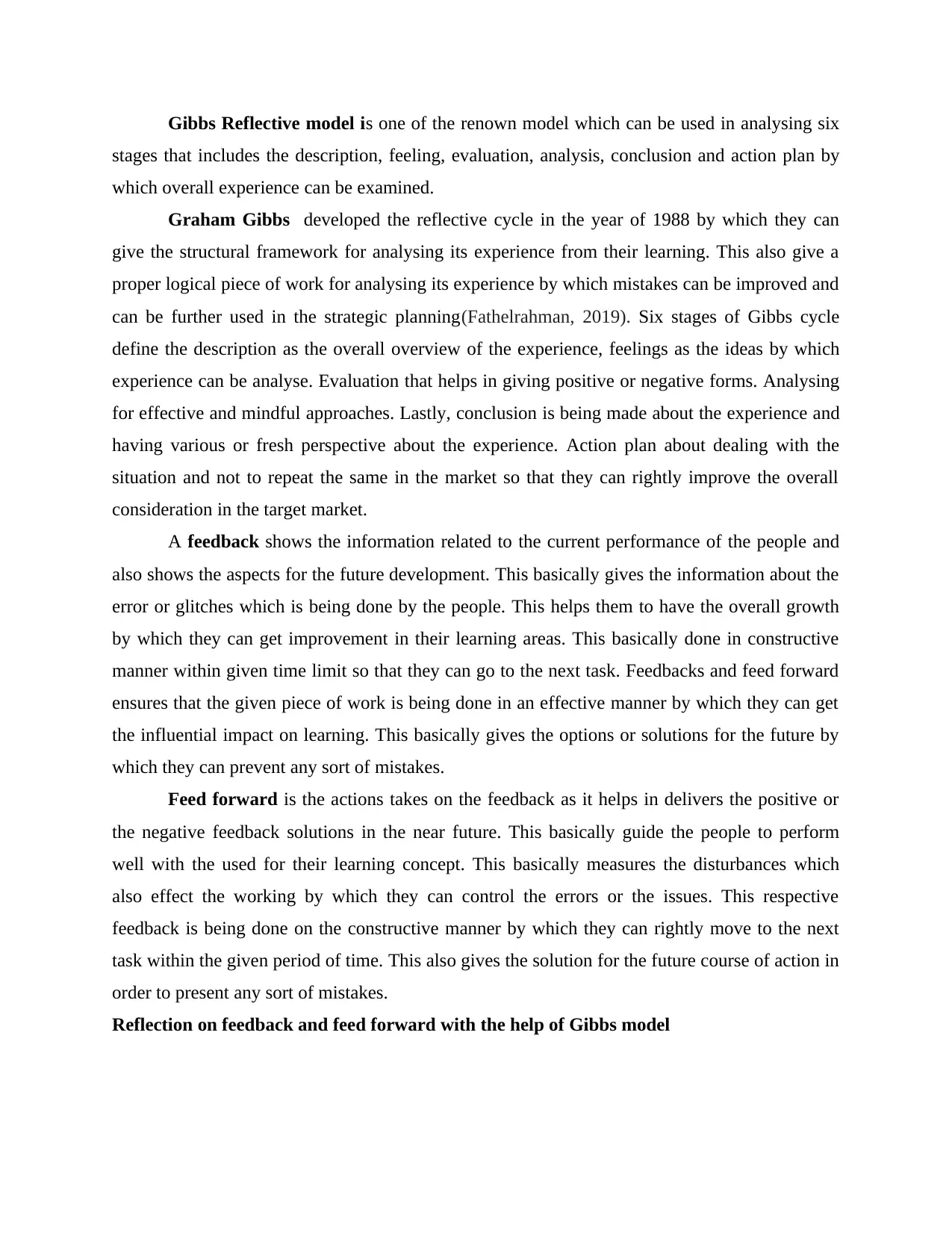
Gibbs Reflective model is one of the renown model which can be used in analysing six
stages that includes the description, feeling, evaluation, analysis, conclusion and action plan by
which overall experience can be examined.
Graham Gibbs developed the reflective cycle in the year of 1988 by which they can
give the structural framework for analysing its experience from their learning. This also give a
proper logical piece of work for analysing its experience by which mistakes can be improved and
can be further used in the strategic planning(Fathelrahman, 2019). Six stages of Gibbs cycle
define the description as the overall overview of the experience, feelings as the ideas by which
experience can be analyse. Evaluation that helps in giving positive or negative forms. Analysing
for effective and mindful approaches. Lastly, conclusion is being made about the experience and
having various or fresh perspective about the experience. Action plan about dealing with the
situation and not to repeat the same in the market so that they can rightly improve the overall
consideration in the target market.
A feedback shows the information related to the current performance of the people and
also shows the aspects for the future development. This basically gives the information about the
error or glitches which is being done by the people. This helps them to have the overall growth
by which they can get improvement in their learning areas. This basically done in constructive
manner within given time limit so that they can go to the next task. Feedbacks and feed forward
ensures that the given piece of work is being done in an effective manner by which they can get
the influential impact on learning. This basically gives the options or solutions for the future by
which they can prevent any sort of mistakes.
Feed forward is the actions takes on the feedback as it helps in delivers the positive or
the negative feedback solutions in the near future. This basically guide the people to perform
well with the used for their learning concept. This basically measures the disturbances which
also effect the working by which they can control the errors or the issues. This respective
feedback is being done on the constructive manner by which they can rightly move to the next
task within the given period of time. This also gives the solution for the future course of action in
order to present any sort of mistakes.
Reflection on feedback and feed forward with the help of Gibbs model
stages that includes the description, feeling, evaluation, analysis, conclusion and action plan by
which overall experience can be examined.
Graham Gibbs developed the reflective cycle in the year of 1988 by which they can
give the structural framework for analysing its experience from their learning. This also give a
proper logical piece of work for analysing its experience by which mistakes can be improved and
can be further used in the strategic planning(Fathelrahman, 2019). Six stages of Gibbs cycle
define the description as the overall overview of the experience, feelings as the ideas by which
experience can be analyse. Evaluation that helps in giving positive or negative forms. Analysing
for effective and mindful approaches. Lastly, conclusion is being made about the experience and
having various or fresh perspective about the experience. Action plan about dealing with the
situation and not to repeat the same in the market so that they can rightly improve the overall
consideration in the target market.
A feedback shows the information related to the current performance of the people and
also shows the aspects for the future development. This basically gives the information about the
error or glitches which is being done by the people. This helps them to have the overall growth
by which they can get improvement in their learning areas. This basically done in constructive
manner within given time limit so that they can go to the next task. Feedbacks and feed forward
ensures that the given piece of work is being done in an effective manner by which they can get
the influential impact on learning. This basically gives the options or solutions for the future by
which they can prevent any sort of mistakes.
Feed forward is the actions takes on the feedback as it helps in delivers the positive or
the negative feedback solutions in the near future. This basically guide the people to perform
well with the used for their learning concept. This basically measures the disturbances which
also effect the working by which they can control the errors or the issues. This respective
feedback is being done on the constructive manner by which they can rightly move to the next
task within the given period of time. This also gives the solution for the future course of action in
order to present any sort of mistakes.
Reflection on feedback and feed forward with the help of Gibbs model
Paraphrase This Document
Need a fresh take? Get an instant paraphrase of this document with our AI Paraphraser
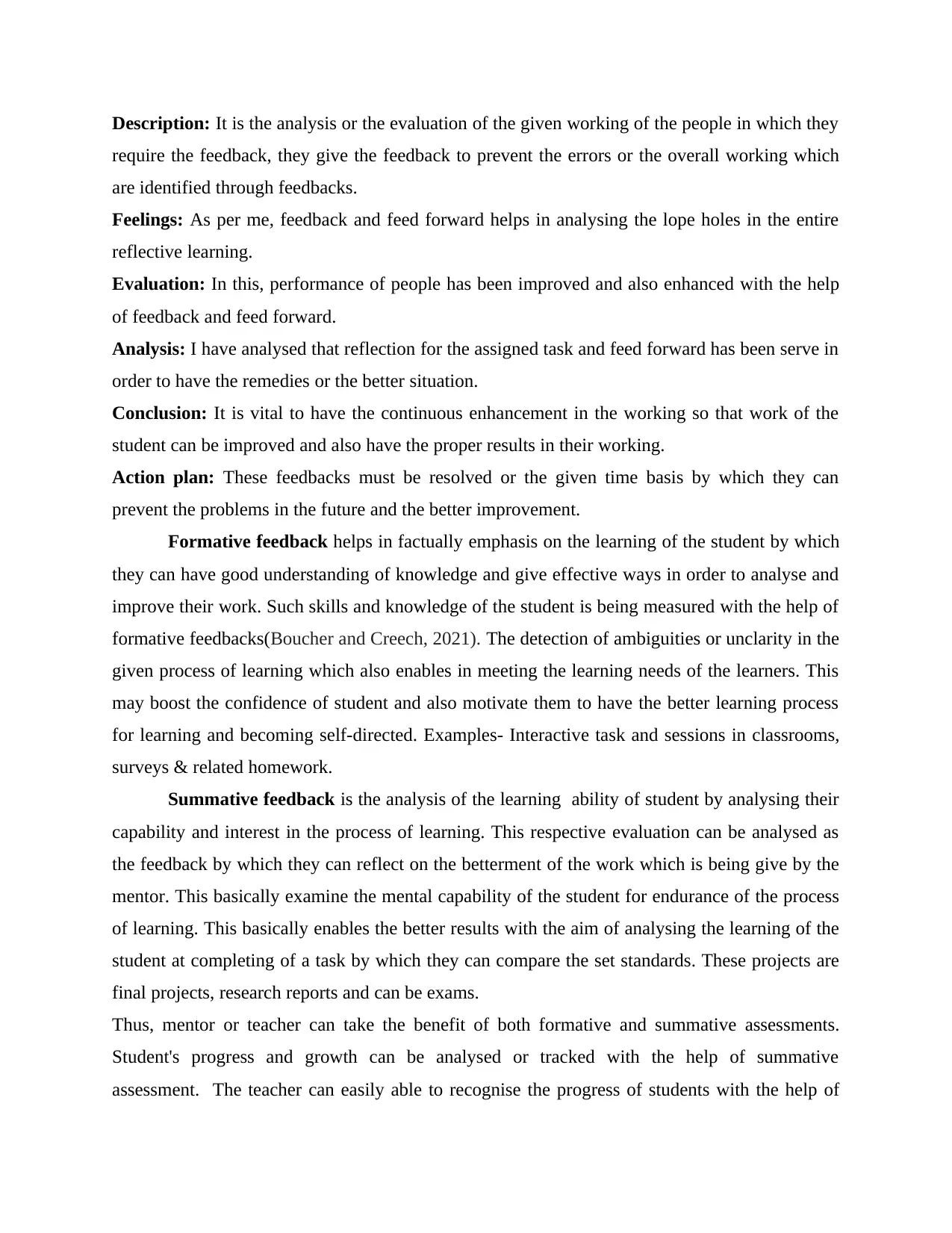
Description: It is the analysis or the evaluation of the given working of the people in which they
require the feedback, they give the feedback to prevent the errors or the overall working which
are identified through feedbacks.
Feelings: As per me, feedback and feed forward helps in analysing the lope holes in the entire
reflective learning.
Evaluation: In this, performance of people has been improved and also enhanced with the help
of feedback and feed forward.
Analysis: I have analysed that reflection for the assigned task and feed forward has been serve in
order to have the remedies or the better situation.
Conclusion: It is vital to have the continuous enhancement in the working so that work of the
student can be improved and also have the proper results in their working.
Action plan: These feedbacks must be resolved or the given time basis by which they can
prevent the problems in the future and the better improvement.
Formative feedback helps in factually emphasis on the learning of the student by which
they can have good understanding of knowledge and give effective ways in order to analyse and
improve their work. Such skills and knowledge of the student is being measured with the help of
formative feedbacks(Boucher and Creech, 2021). The detection of ambiguities or unclarity in the
given process of learning which also enables in meeting the learning needs of the learners. This
may boost the confidence of student and also motivate them to have the better learning process
for learning and becoming self-directed. Examples- Interactive task and sessions in classrooms,
surveys & related homework.
Summative feedback is the analysis of the learning ability of student by analysing their
capability and interest in the process of learning. This respective evaluation can be analysed as
the feedback by which they can reflect on the betterment of the work which is being give by the
mentor. This basically examine the mental capability of the student for endurance of the process
of learning. This basically enables the better results with the aim of analysing the learning of the
student at completing of a task by which they can compare the set standards. These projects are
final projects, research reports and can be exams.
Thus, mentor or teacher can take the benefit of both formative and summative assessments.
Student's progress and growth can be analysed or tracked with the help of summative
assessment. The teacher can easily able to recognise the progress of students with the help of
require the feedback, they give the feedback to prevent the errors or the overall working which
are identified through feedbacks.
Feelings: As per me, feedback and feed forward helps in analysing the lope holes in the entire
reflective learning.
Evaluation: In this, performance of people has been improved and also enhanced with the help
of feedback and feed forward.
Analysis: I have analysed that reflection for the assigned task and feed forward has been serve in
order to have the remedies or the better situation.
Conclusion: It is vital to have the continuous enhancement in the working so that work of the
student can be improved and also have the proper results in their working.
Action plan: These feedbacks must be resolved or the given time basis by which they can
prevent the problems in the future and the better improvement.
Formative feedback helps in factually emphasis on the learning of the student by which
they can have good understanding of knowledge and give effective ways in order to analyse and
improve their work. Such skills and knowledge of the student is being measured with the help of
formative feedbacks(Boucher and Creech, 2021). The detection of ambiguities or unclarity in the
given process of learning which also enables in meeting the learning needs of the learners. This
may boost the confidence of student and also motivate them to have the better learning process
for learning and becoming self-directed. Examples- Interactive task and sessions in classrooms,
surveys & related homework.
Summative feedback is the analysis of the learning ability of student by analysing their
capability and interest in the process of learning. This respective evaluation can be analysed as
the feedback by which they can reflect on the betterment of the work which is being give by the
mentor. This basically examine the mental capability of the student for endurance of the process
of learning. This basically enables the better results with the aim of analysing the learning of the
student at completing of a task by which they can compare the set standards. These projects are
final projects, research reports and can be exams.
Thus, mentor or teacher can take the benefit of both formative and summative assessments.
Student's progress and growth can be analysed or tracked with the help of summative
assessment. The teacher can easily able to recognise the progress of students with the help of
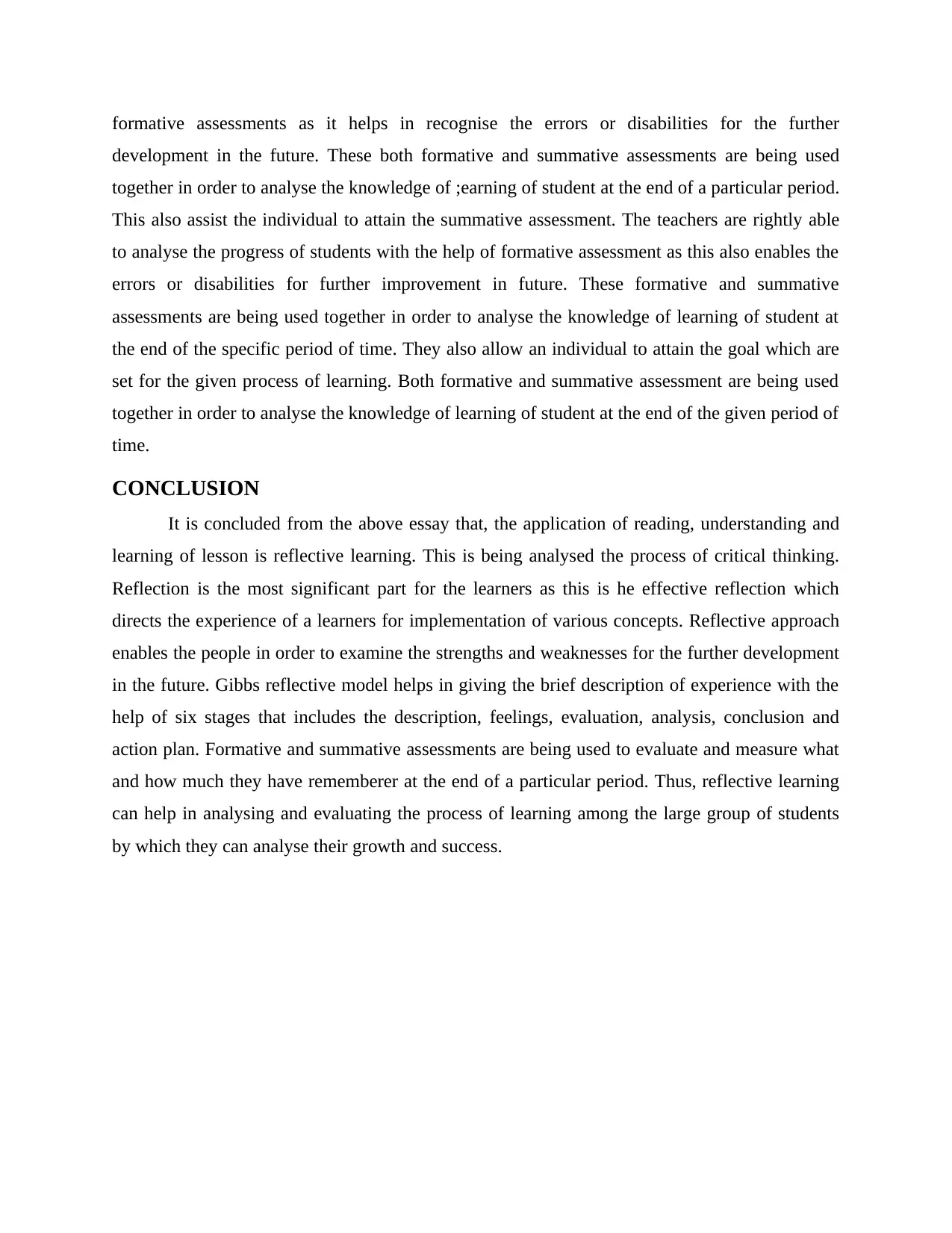
formative assessments as it helps in recognise the errors or disabilities for the further
development in the future. These both formative and summative assessments are being used
together in order to analyse the knowledge of ;earning of student at the end of a particular period.
This also assist the individual to attain the summative assessment. The teachers are rightly able
to analyse the progress of students with the help of formative assessment as this also enables the
errors or disabilities for further improvement in future. These formative and summative
assessments are being used together in order to analyse the knowledge of learning of student at
the end of the specific period of time. They also allow an individual to attain the goal which are
set for the given process of learning. Both formative and summative assessment are being used
together in order to analyse the knowledge of learning of student at the end of the given period of
time.
CONCLUSION
It is concluded from the above essay that, the application of reading, understanding and
learning of lesson is reflective learning. This is being analysed the process of critical thinking.
Reflection is the most significant part for the learners as this is he effective reflection which
directs the experience of a learners for implementation of various concepts. Reflective approach
enables the people in order to examine the strengths and weaknesses for the further development
in the future. Gibbs reflective model helps in giving the brief description of experience with the
help of six stages that includes the description, feelings, evaluation, analysis, conclusion and
action plan. Formative and summative assessments are being used to evaluate and measure what
and how much they have rememberer at the end of a particular period. Thus, reflective learning
can help in analysing and evaluating the process of learning among the large group of students
by which they can analyse their growth and success.
development in the future. These both formative and summative assessments are being used
together in order to analyse the knowledge of ;earning of student at the end of a particular period.
This also assist the individual to attain the summative assessment. The teachers are rightly able
to analyse the progress of students with the help of formative assessment as this also enables the
errors or disabilities for further improvement in future. These formative and summative
assessments are being used together in order to analyse the knowledge of learning of student at
the end of the specific period of time. They also allow an individual to attain the goal which are
set for the given process of learning. Both formative and summative assessment are being used
together in order to analyse the knowledge of learning of student at the end of the given period of
time.
CONCLUSION
It is concluded from the above essay that, the application of reading, understanding and
learning of lesson is reflective learning. This is being analysed the process of critical thinking.
Reflection is the most significant part for the learners as this is he effective reflection which
directs the experience of a learners for implementation of various concepts. Reflective approach
enables the people in order to examine the strengths and weaknesses for the further development
in the future. Gibbs reflective model helps in giving the brief description of experience with the
help of six stages that includes the description, feelings, evaluation, analysis, conclusion and
action plan. Formative and summative assessments are being used to evaluate and measure what
and how much they have rememberer at the end of a particular period. Thus, reflective learning
can help in analysing and evaluating the process of learning among the large group of students
by which they can analyse their growth and success.
⊘ This is a preview!⊘
Do you want full access?
Subscribe today to unlock all pages.

Trusted by 1+ million students worldwide
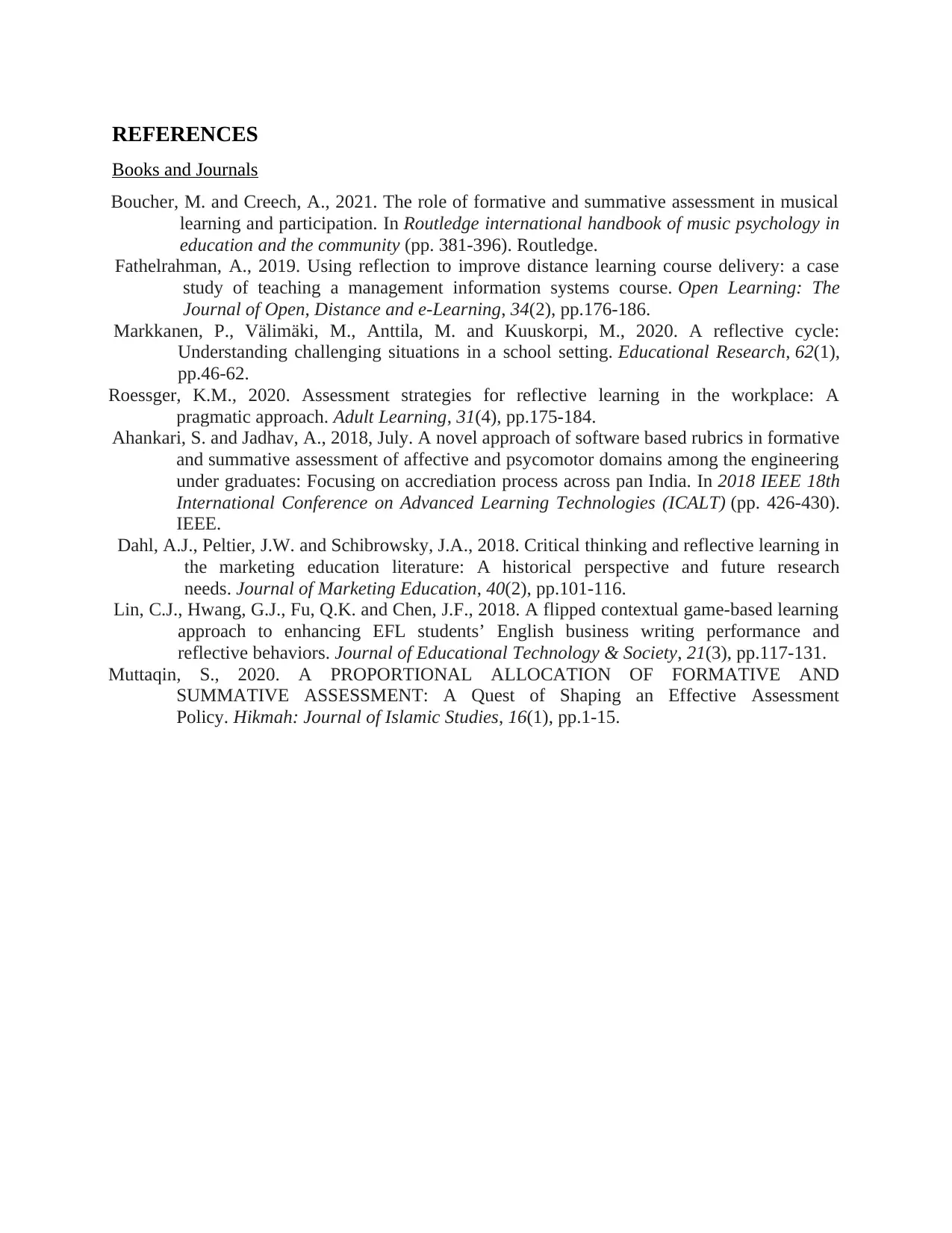
REFERENCES
Books and Journals
Boucher, M. and Creech, A., 2021. The role of formative and summative assessment in musical
learning and participation. In Routledge international handbook of music psychology in
education and the community (pp. 381-396). Routledge.
Fathelrahman, A., 2019. Using reflection to improve distance learning course delivery: a case
study of teaching a management information systems course. Open Learning: The
Journal of Open, Distance and e-Learning, 34(2), pp.176-186.
Markkanen, P., Välimäki, M., Anttila, M. and Kuuskorpi, M., 2020. A reflective cycle:
Understanding challenging situations in a school setting. Educational Research, 62(1),
pp.46-62.
Roessger, K.M., 2020. Assessment strategies for reflective learning in the workplace: A
pragmatic approach. Adult Learning, 31(4), pp.175-184.
Ahankari, S. and Jadhav, A., 2018, July. A novel approach of software based rubrics in formative
and summative assessment of affective and psycomotor domains among the engineering
under graduates: Focusing on accrediation process across pan India. In 2018 IEEE 18th
International Conference on Advanced Learning Technologies (ICALT) (pp. 426-430).
IEEE.
Dahl, A.J., Peltier, J.W. and Schibrowsky, J.A., 2018. Critical thinking and reflective learning in
the marketing education literature: A historical perspective and future research
needs. Journal of Marketing Education, 40(2), pp.101-116.
Lin, C.J., Hwang, G.J., Fu, Q.K. and Chen, J.F., 2018. A flipped contextual game-based learning
approach to enhancing EFL students’ English business writing performance and
reflective behaviors. Journal of Educational Technology & Society, 21(3), pp.117-131.
Muttaqin, S., 2020. A PROPORTIONAL ALLOCATION OF FORMATIVE AND
SUMMATIVE ASSESSMENT: A Quest of Shaping an Effective Assessment
Policy. Hikmah: Journal of Islamic Studies, 16(1), pp.1-15.
Books and Journals
Boucher, M. and Creech, A., 2021. The role of formative and summative assessment in musical
learning and participation. In Routledge international handbook of music psychology in
education and the community (pp. 381-396). Routledge.
Fathelrahman, A., 2019. Using reflection to improve distance learning course delivery: a case
study of teaching a management information systems course. Open Learning: The
Journal of Open, Distance and e-Learning, 34(2), pp.176-186.
Markkanen, P., Välimäki, M., Anttila, M. and Kuuskorpi, M., 2020. A reflective cycle:
Understanding challenging situations in a school setting. Educational Research, 62(1),
pp.46-62.
Roessger, K.M., 2020. Assessment strategies for reflective learning in the workplace: A
pragmatic approach. Adult Learning, 31(4), pp.175-184.
Ahankari, S. and Jadhav, A., 2018, July. A novel approach of software based rubrics in formative
and summative assessment of affective and psycomotor domains among the engineering
under graduates: Focusing on accrediation process across pan India. In 2018 IEEE 18th
International Conference on Advanced Learning Technologies (ICALT) (pp. 426-430).
IEEE.
Dahl, A.J., Peltier, J.W. and Schibrowsky, J.A., 2018. Critical thinking and reflective learning in
the marketing education literature: A historical perspective and future research
needs. Journal of Marketing Education, 40(2), pp.101-116.
Lin, C.J., Hwang, G.J., Fu, Q.K. and Chen, J.F., 2018. A flipped contextual game-based learning
approach to enhancing EFL students’ English business writing performance and
reflective behaviors. Journal of Educational Technology & Society, 21(3), pp.117-131.
Muttaqin, S., 2020. A PROPORTIONAL ALLOCATION OF FORMATIVE AND
SUMMATIVE ASSESSMENT: A Quest of Shaping an Effective Assessment
Policy. Hikmah: Journal of Islamic Studies, 16(1), pp.1-15.
1 out of 7
Related Documents
Your All-in-One AI-Powered Toolkit for Academic Success.
+13062052269
info@desklib.com
Available 24*7 on WhatsApp / Email
![[object Object]](/_next/static/media/star-bottom.7253800d.svg)
Unlock your academic potential
Copyright © 2020–2025 A2Z Services. All Rights Reserved. Developed and managed by ZUCOL.




